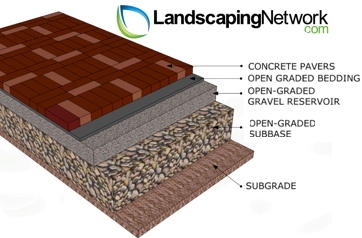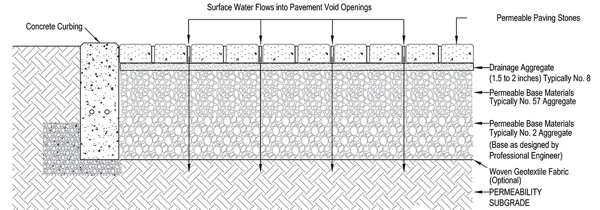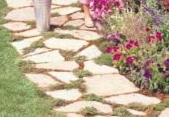
Gravel Paths:
Several types of inexpensive gravel are available for paths. Common types are: crushed gravel, crushed limestone and pea rock. For a path that's more formal or longer lasting than a mulch path, consider washed gravel, crushed stone or crushed shells. These materials last indefinitely and only need occasional weeding to look their best. If you want to run a wheelbarrow or lawn mower along the path, choose crushed stone rather than smooth pebbles. The jagged edges of crushed stone lock together to form a firm surface. Crushed stone is also less likely to get kicked out into the yard.
If you're going to run a wheelbarrow over it use crushed stone (small angular stone) and tamp it after leveling it. (Pea rock or other rounded stone won't compact.)
Small, angular stones instead of rounded pebbles. They lock together for a more stable walking surface.
Width:
Primary path- 48" for 2 people
Secondary path and wheelchair path - 36"
Minimum - 2'
A garden cart requires about 3 to 4 ft
A path 30 feet or longer should be five to six feet wide to make it fit the space more comfortably.
Depth:
The base should be 4 in. deep in mild-winter climates with well-drained soil, and 5 to 8 in. deep if you live where the ground freezes.
The video from - GardenContinuumINC, says to
Excavate 9 inches same as patio or driveway, that way you can add pavers later if you change your mind.

Crushed stone will provide a more stable sub-base. When it tamped down the angular stone has interlocking properties that make it more solid.
"Site pack" or "Quarry Process Stone" or "Road Base" is a gravel stone dust mix or quarry process )that also results in a solid surface.
- Set edging so it ends up about an inch above the fill material.
- Cover the soil with landscape fabric to deter weeds and prevent the fill material from mixing with the soil. Don't use plastic. It'll catch water and create a soggy path.
Use a plate vibrator to tamp down the base.
Edging and Borders:
Plastic, steel or aluminum, bender board, rocks, bricks, landscape timbers.
Grade:
The proper slope should be ¼” for every 1 foot.
Paver path:


Stone dust, sometimes called rock dust, is a byproduct of crusher run that's provided the bedding layer for many a paver project over the years. While it can work in some construction applications, there's a growing recognition that sand - washed concrete sand in particular - has proven far more stable and exhibits properties that make it superior to stone dust for bedding in a number of ways.
Geotextile fabric (landscape cloth) at the bottom can help with settling.
Top Coat:
You sprinkle PermaSand or Polymeric Sand on the top and sweep it into the joints between the pavers.
It comes with a water-activated polymer mixed in. After applying the material to the paved surface, the sand is sprayed down with water which causes the polymers to harden. This then secures the sand in place.
This secures the pavers and stops erosion and weed growth.
Permeable interlocking concrete pavement (PICP)
Allows water to flow thru the pavers and base. It is a durable cost-effective solution for compliance to stormwater regulations. PICP can reduce runoff and pollutants from walkways, patios, driveways, parking lots, ...
Some areas require a permeable application, so the base is #2 washed clean stone. 1 1/2 to 2 1/2" stone.

#2 - 2 - 2 1/2"; #8 = 3/8 - 1/2"; #57 - 1 to 1 1/2".
Even if you don't plan on lighting the path now, install electrical conduit just above the base in case you decide to add it later.
See also:
Driveways and Walkways for slope guidelines.
Stone Paths:

Easiest and fastest way to build a path.
Don't require any digging.
Requires less material since they are spread apart.
Flagstone:
$2 - $5 / sq ft.
- Sandstone, most often found in southwestern regions like Arizona, costs about $125 per ton.
- Quartzite is harder than sandstone and comes in a wide array of colors and patterns. It costs about $575 per ton.
- Bluestone is so named because of its deep blue undertone. It costs about $330 per ton.
- Limestone is found almost everywhere on the planet. It is frequently used as flagstone material due to its low cost (from $80 to $100 per ton). The downside to limestone is that it cracks easily and may require a bit of maintenance and repair.
- Brickyard Vacaville
- California Gold flagstone $0.29/lb
- Slate - Often referred to as flagstone but
- Black Slate
See Difference Between Slate and Flagstone | Hunker
 My Davis front yard:
My Davis front yard:
Materials 100 sq ft path
Bender board & Stakes $78
Road Stone 1 yd $41
delivery $25
Flagstone - California Gold (Slate) 250# @ 35¢ $95
Border - Mission Paver Mendocino paver 125 @ 48¢ $60
Gravel - 7 cu ft of Lodi pea gravel $35
Total $334
Aggregate Types:
Sand and gravel
Crushed stone - Sharp edges
River Stone -Cobble - - Smooth edges
Pea stone - Small river stone
Decorative Stone - Large stone for landscaping
Boulders
See Construction Aggregates - Stone, Sand and Gravel - Todd's Redi-MixTodds Redi Mix
There are several different sizing systems and nomenclatures.
e.g. MD #2 = 2 - 2 1/2"; MD #8 = 3/8 - 1/2"; ASTM #57 = 1 to 1 1/2".
See Aggregates
Pictures:
More images on pinterest here and
here
Links:
Aggregates
Affordable Garden Path Ideas | The Family Handyman
9 Ways to Create a Garden Path | Midwest Living
aggregates | mason sand | gravel | stone dust | concrete sand| top soil
aggregates
42 Amazing DIY Garden Path and Walkways Ideas - GoWritter
Joel M. Lerner - The Perfect Garden Path, Step by Step
How to lay a path | Wickes - YouTube
Here's How to Build a Perfect Path | This Old House
More Pictures
last updated 10 Oct 2018
 Home - Garden
Home - Garden
 Landscaping
Landscaping

 Home - Garden
Home - Garden
 Landscaping
Landscaping
